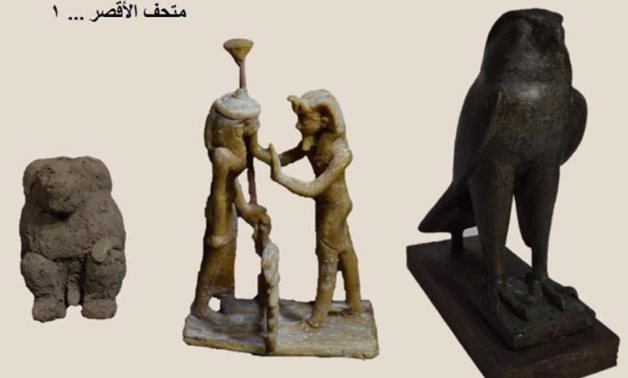
File: 3 pieces in one image won, illustrating the stages of metal casting in ancient Egypt and showing the God "Horus" made of bronze, God "Maat" made of beeswax, and God "Gahoty" made of clay.
CAIRO - 15 May 2021: A monthly tradition is performed by the Egyptian museums under the Supreme Council of Antiquities, where a distinctive display is held of an artifact chosen by the public through voting on the social networking site Facebook of these museums to be the "piece of the month".
Royal Chariots Museum in Boulaq:
Piece 2 displayed in the museum's reception hall, the "Jananyar Hanem Painting", a life-size oil painting by Jananyar Hanem, one of Khedive Ismail's wives won the vote for this month.
Kom Aushim Museum of Fayoum:
One of the museum's collections in the ground floor museum exhibition scenario, an almond-shaped saddle with two-star decorations and figures, olive color, made of porcelain and dating back to the Fatimid era was chosen.
Sohag Museum:
Piece 1, a double statue of the workers' chief (Njm Abe), who was a senior state man who rose to the office where he held the title of foreman, an observer of the high priests, and the sole prince of the king won.
Luxor Mummification Museum:
The audience chose a newly mummified duck artifact, which was embalmed by Dr. Zaki Iskandar in 1942.
Royal Jewelry Museum in Alexandria:
Piece 3 was the winning piece, it is the box of Nashuk Muhammad Ali Pasha from king Farouk's possessions, which is an oval-shaped box made of gold and silver, the cover of the box moves using a hinge, and is mediated by a silver ansial that reads (Muhammad Ali) studded with diamonds, next to it an ornament in the form of an olive branch studded with diamonds.
Museum of Islamic Art:
The winning piece was a glass with metallic sparkle on it and a drawing of a Fatimid deer.
5th century H/11 AD.
King Farouk Corner Museum in helwan:
A photograph of the wedding of King Farouk and Queen Nariman with the signature (Riad Shehata, photographer of the King) inside a gilded wood frame topped with the shape of the Royal Crown that is displayed in the Queen's bedroom was the winning piece.
Sharm el-Sheikh Museum:
A piece dating back to the middle state era depicting the bread industry in ancient Egypt where the person in the back makes bread dough and puts it in a baking mold and gives it to the front person to put it in the oven in front of him won.
Hurghada Museum:
Piece 1, a statue of colored limestone that embodies the profession of "tahan", where this small statue depicts a man who is actively grinding grains since bread was an essential food in ancient Egypt won.
Beni Suef National Archaeological Museum:
Piece 1, a 1501 limestone statue of a bread-making maid with red and black remains, has been chosen.
Ismailia Museum:
A funeral plaque painting of a Hathor priest with the God Ozer, and the sun's winged disc - Limestone - the ancient state was the winning piece.
Tel Basta Museum:
A set of saddles, the lighting tools of the old Egyptian, where the oil was placed from the top of the fuse was chosen.
Suez Museum:
A set of dried fish won.
Coptic Museum:
The icon of the resurrection of Christ from the grave where the shrouds were placed was chosen, on the left is a group of women heading towards the grave while two of the three soldiers guarding the tomb are asleep in front of the tomb.
National Police Museum of the Castle:
An artifact representing the logo of the Egyptian police was chosen as an eagle with the word police between its feet and surrounded by two branches of branches representing social peace and topped with the name of the Arab Republic of Egypt.
Al-Manial Museum:
An oil photograph of Khedive Ismail standing on the right of a double pole on a base was chosen.
Kafr Al-Sheikh Museum:
A glass niche colored translucent blue was chosen.
Greek-Roman Museum:
A bronze head of Emperor Hardian was chosen, he visited Egypt and spent 8-10 months on an indigo trip and founded a new city in Minya named After Antinopolis (currently Sheikh Abada near Tuna al-Jabal), and this artifact moved around with the pieces of the "Secrets of sunken Egypt" exhibition, and was returned to be among the main exhibits of the Greek-Roman Museum when it opens soon.
New Valley Museum:
A wood statue of the Alba bird with its wings on its head and a sun disk over with a layer of stained plaster and gilded face, dating back to the Greek-Roman era was the chosen piece.
Luxor Museum:
3 pieces in one image won, illustrating the stages of metal casting in ancient Egypt and showing the God "Horus" made of bronze, God "Maat" made of beeswax, and God "Gahoty" made of clay, and these pieces date back to the era of the modern state.
There is only a little metal sculpture in ancient Egypt and the metal was melted and reused and this method is called the lost wax.
Matrouh Antiquities Museum:
The winning piece is the icon of St. Morcos the Apostle, which shows St. Morcos, founder of the Church of Alexandria and the first patriarch of Christians in Egypt, and this icon is made of colored wood and dates back to the Coptic era.

Comments
Leave a Comment